
NAKANISHI Nobuhiro Solo Exhibition――Transparent view――
April 23 (Sat) ~ June 19 (Sun), 2011 10:00 - 18:00 / Free
air2011-1en
NAKANISHI Nobuhiro
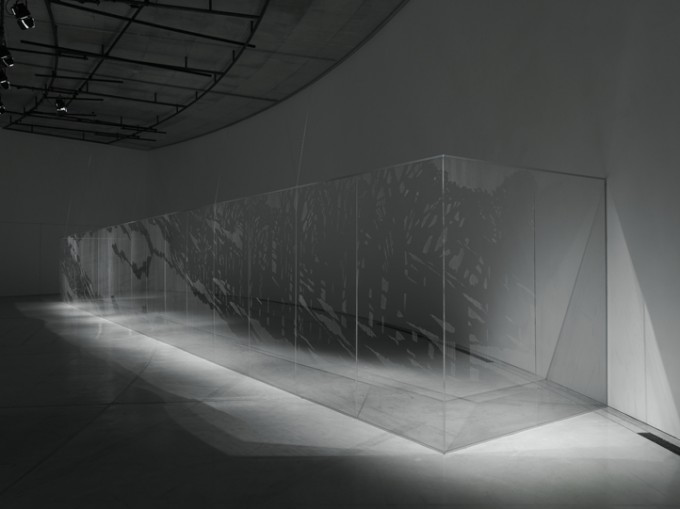
Transparent view
Body Perceiving---Time in “Layer Drawing” and Space in “Stripe Drawing”
KONDO Yuki
In his lectures and writings, NAKANISHI Nobuhiro often mentions unfinished works by Michelangelo. In some way it is related to the basis of his sculptural faculty of observation and production method, though he presents his works using varied means as a medium. What is important here, however, is that he has touched upon his two physical but vicarious experiences taking Michelangelo as an example. According to Nakanishi, viewers of Michelangelo’s sculptures of slaves are having two kinds of vicarious experiences: one is their vicarious experience through the body perceiving the character sculptured with a carefully thought-out look and a twisted pose, and the other is that viewers feel and sense vicariously through the sculptor who made the statue in marble. It might be a viewpoint peculiar to artists to read the sculptor’s feelings and senses in a figure sculpture being carved to perfection, which looks almost inappropriate to the materiality of marble. After all, the above-mentioned reference about assimilating, through the viewer’s body, different kinds of physical senses and feelings between the artist and the created character concerning the same image is applicable to Nakanishi’s work.
Because many motifs of his works come from “scenery of nature,” we scarcely experience vicarious physical feelings of the created character. Though it is not the scenery regarded as a single still picture that one’s eyes caught, it is the “scenery” presented as having time and movement obtained through one’s physical perceptual experience. Here again, looking at the work, viewers will experience vicariously two kinds of physical perception: one is that they relive their past experience of having seen scenery similar to this anonymous one, and the other is that they experience vicariously how the artist perceived the scenery to create the work.
As a matter of course, we do not perceive the world only through a fixed visual image like a photograph focused from a fixed point of view. You might say that the process of perceiving an object is a close, continuous relationship between brain, motor nerves and retinas directed towards the overall picture of the object. In producing his work, Nakanishi seems to show this continuous relationship using a continuous process, not excluding retinal visual image. Viewed in this light, the “Layer Drawing” series shows the continuity of movement, while the “Stripe Drawing” series that of space. In this way, he is probably presenting the image perceived through the body, comprehending the process of grasping the whole picture of the object.
In “Layer Drawing #001 - #081” (2004-5), by making up the whole picture with the accumulation of continuous changes of time and movement of each object and scene, he presents in a form the process of grasping objects beyond the two-dimensional visual image. The pieces look three-dimensional without reality contained in small shining boxes (the image seems to be floating in a small box because 24 slide-mounts are piled up). However, this object is not three-dimensional with depth. It has another dimension, that is, the element of continuous movement produced by continuous changes in the object and scenery.
In “Layer Drawing -- Fog” and “Layer Drawing -- Cloud,” (2005) on the other hand, the same approach is adopted, but the element of viewers’ movement has been brought in. This continuity of movement refers not only to the artist’s perception but also the viewer’s physical experience. In order to look at this work, approximately 20m long in detail, the viewer needs to walk that long. Looking sideways at “Layer Drawing Cloud,” in which the sunrise was photographed at a fixed observation point, while walking along, viewers feel that they see slightly shiny clouds floating slowly, due to after-images caused by their movements. The viewers’ perception of continuous time, which they experience as they look at a difficult-to-capture phenomenon like ever-changing clouds and light, is brought back to their senses. In “Layer Drawing Fog,” viewers feel as if they were actually walking in the forest looking at thick, milk-white fog changing its appearance and trees becoming visible one after another. There, they can also feel the artist’s view and his walk, and gradually assimilate them all. On turning your eyes sideways, however, you will find “gap” of discontinued time, and the materiality of film is exposed. This clear difference could be compared to the borderline between the image sculptured by Michelangelo and marble as a substance.
As this work produced for the ACAC artist-in-residence program 2005 is displayed along the curved line of the characteristic semicircle of the gallery, 100 sheets of film are arranged with slight gap in-between. Accordingly, space behind each photograph permeates through the picture so that the image floats in the inorganic space. Being arranged in piles, the films show fog and clouds thicker than real and seem to be a mass having jellylike weight and non-fluidity/non-motility. It is suspended in midair as cutoff time. That time is different from the time that we recognize when we read the hands of the clock moving on the dial, because it begins to move only when we move.
On the other hand, “Stripe Drawing” reminds us of spatial continuity. Nakanishi produced this new work “Stripe Drawing – Transparent view” (2011) especially for this solo exhibition. Twelve acrylic boards are placed in a U-shape, and viewers can go inside. Long, straight, thin grooves are cut on the surface of the board by an engraver, and on the transparent surface are forms that remind us of trees in the forest and floating clouds. Those white lines look as if they were sprayed on the acrylic board and look floating and full, rather than just vertical. Not to speak of Nakanishi’s disclosure, it is exactly a scene of snow. Have you ever walked or driven in a blinding snowstorm? Untouchable white is all over the world. The familiar open space is covered with untouchable white. Even when I am sure that my eyes are open, and my feet (car) on the ground, it is difficult to keep balance. Surrounded by overwhelming whiteness and coldness, I feel all my senses becoming numb.
Entering the U-shaped corner, because sound in the surroundings is cut off, I begin to feel my senses weakened as if wrapped in a thin membrane. People and the wall on the other side are seen through the transparent acrylic, and it is difficult to establish the point of focus between the front and the beyond, or lines and blank space. With focus of my eyes on the lines, I see the white world come to the front, and when the focus is on the backdrop, I see space between the backdrop and myself filled with the white world. For “Aomori Reflection,” (2010) a monument in front of Shin-Aomori Station, which was made prior to this work, he used the same method, but made the work on a mirror plane. Therefore, viewers standing in front of the work and things in the background are reflected on the blank surface, so that the picture and the blank mirror as well as the real and the depicted scenery are coming and going in front of my eyes. In this work, on the other hand, while the viewer’s body remains there spatially detached, his or her eyes look penetrating forward. So, there is a feeling that the space seems to spread to the front as well as to the rear over the boundary of the body.
This “Stripe Drawing” series is Nakanishi’s two-dimensional work, which he has continuously produced since 2003. He expresses his work in words as follows: “It is an act of touching what I am eager to touch but unable to do.”[1] In the “Stripe Drawing” series, a vacant space is filled with thin lines, and the blank part is loaded with suggestive forms. In other words, you might say that he replaces, with lines, a sensation of feeling something invisible or something untouchable like air and light filling up the place. It is not simple replacement of perception with something else, because, for instance, time he spent to get to that certain scenery and related memories must be included. Looking closely at vertical lines drawn freehand in “Stripe Drawing,” you see those lines quiver slightly as his body shook despite himself. Those lines that remind us of the artist’s body movement show us an individual’s physical feeling, and the “scenery” expressed as the collective form seems to emerge as scenery of the expanded body, which is associated with ambiguous relationship with the world and an expanse that begins to melt into space.
“Stripe Drawing Endless” (2009) displayed in the same exhibition depicts this point graphically. A video showing pencil drawing on paper is on loop, and it is overlapped with the state of the body that is endlessly expanding without knowing where to draw a line between the body and scenery. It is inner space as well as outer space that can be obtained by reversing the relationship between space and an object/material that exists in space with weight.
I believe that Nakanishi uses different media for the work of expression because he tries to grasp the overall image of time and space, which are continuous and inseparable, through the body. It can be said that by grasping untouchable and invisible space and time through the body, he tries to visualize and represent them as images reflected on the body including various internal senses and movements, which are considered to be some common feelings.
[1]“NAKANISHI Nobuhiro---touching the untouchable” (interviewed by KICHISE Emi), “Ripple No. 23,” March 1, 2008, Gallery Nomart, p. 17.
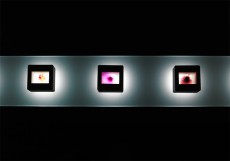
Layer Drawing #001 ー #081
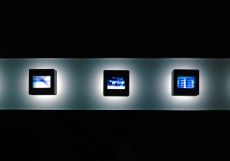
Layer Drawing #001 ー #081

Stripe Drawing ー Endless
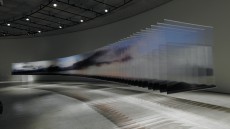
Layer Drawing ー Cloud
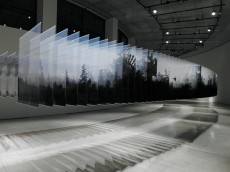
Layer Drawing ー Fog
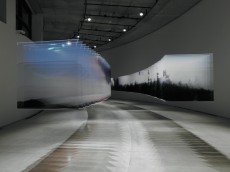
Layer Drawing ー Cloud / Fog
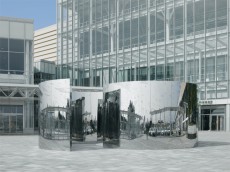
Aomori Reflection

Aomori Reflection
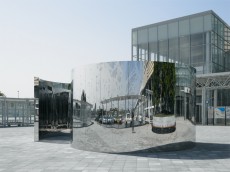
Aomori Reflection
中西信洋展 透過する風景――Transparent view――
2011年4月23日(土)~6月19日(日)10:00 - 18:00 入場無料
中西信洋
NAKANISHI Nobuhiro

《transparent view》
知覚する身体:《Layer Drawing》の時間、《Stripe Drawing》の空間
近藤由紀
中西は自身の文章やレクチャーにおいて、しばしばミケランジェロの未完の像を例に取り上げる。それは中西が多様なメディアによって作品を展開しながらも、彫刻的な観察と制作の方法がその基盤にあるということとも関係するのだが、ここで注目したいのはミケランジェロを例にとった二つの身体的な追体験についての言及である。中西はここで鑑賞者は二種類の追体験をするという。一つは彫像の考え抜かれた一瞬の表情や捻じれた身体から想起される作中人物の身体あるいは感情についての追体験であり、もう一つは大理石を彫ってその像を制作した彫刻家の感情や感覚についての追体験である。大理石の物質感とは不釣合なほど完成形に近い、彫り出されつつある人物像の上ののみ痕に、彫刻家の感情や感覚をみるのは、おそらく制作者特有の視点であろう。だが同一のイメージの上で、制作者と作中人物という異なる種類の身体感覚や感情を、見る者の身体を媒介に同化させたこの言葉は、中西の作品にあてはまる。
中西の作品のモチーフの多くは「自然の風景」である。それゆえ作品人物の身体の感覚を追体験することはない。一方でそれは目が捉えた一枚の静止画像としての風景ではなく、身体的な知覚体験を通した時間と運動を孕んだ「風景」として提示される。そのことでここでも見る者は作品体験として二つの身体的な知覚を追体験することとなる。一つは今そこにある匿名化された風景と同じような風景を体験した自分自身の経験の追体験であり、もう一つはその作品としての風景を作りだした作家の知覚の追体験である。
当然のことながら世界の知覚は一枚の写真のように固定された視点が焼き付けた固定された視覚イメージによってなされるのではない。ある対象の知覚は、脳、運動神経、網膜が対象そのものの全体性に向かって緊密かつ連続的な関係性をもって作られていくといえるだろう。中西は作品において網膜的な視覚イメージを排除せず、こうした連続的な関係性を、連続的なプロセスを用いて提示しようとしているように思われる。そう考えると≪Layer Drawing≫のシリーズは運動の連続性を、≪Stripe Drawing≫のシリーズは空間の連続性を示すことで対象の全体像把握のプロセスを包括しつつ、その身体を通じた知覚イメージを提示しているといえるだろう。
≪Layer Drawing #001—#081≫(2004-2005年)は、それぞれの事物、風景の時間や運動の連続的な変化を重ねて全体像を形成することにより二次元的な視覚イメージを超えた対象把握のプロセスを一つの形として提示している。それらは小さな光る箱(スライドマウントを24枚重ねているために、小さな箱の中にイメージが浮かんでいるようにみえる)の中におさめられた実体のない立体物、3Dイメージのようにみえる。だがそれは奥行きや深さが加わった3Dではなく、事物、風景の連続的な変化、すなわち連続的な運動性がもう一つのディメンションとして加えられている。
これに対し≪Layer Drawing – Fog≫、≪Layer Drawing – Cloud≫(2005年)は、同様の手法が用いられながらも、そこに観客の移動という見る者の運動性が加えられる。全長約20mのこの作品を詳細にみるためにはその長さ分だけ歩かなければならない。定点で撮影された日の出の様子を撮影した≪Layer Drawing – Cloud≫は、視線を斜めに置き移動しながら作品を眺めていると、身体の移動によって残像効果が生じ、うっすらと光を孕んだ雲がゆらゆらと動いているように見え、刻々と変化する雲や光といった捉え難い現象を眺めているその連続する時間感覚がよみがえってくる。また≪Layer Drawing – Fog≫は、歩行によって変化する乳白色の濃い霧とそこから次々に出現する木々を眺めることにより、自らが森の中を歩いているような心地がするとともに、作者の目や歩行も感じられ、それが次第に同化していくようである。しかしふと目線を真横に移すとそこには断絶された時間としての「すき間」があり、フィルムのフィルムとしての物質性があらわになる。その境目はまるでミケランジェロの彫り出された像と生の大理石の境をみるかのようである。
2005年に国際芸術センター青森のアーティスト・イン・レジデンス・プログラムにおいて滞在制作されたこの作品は、特徴的な半円形のギャラリーのカーブにそって展示されることにより、100枚のフィルムの並びにずれを生じさせる。それにより作品は、無機質な空間の中にぽっかりと浮かんだようになる。透明のフィルムの上に焼き付けられた写像は、重ねられることで現実の霧や雲よりも厚く、寒天のような重量感と非流動性/非運動性を持った塊のようになり、切り離された時間として宙づりにされる。その時間は時計の針が一目盛り動いたことで時の進行を認識するのとは逆で、我々が動いて初めて動き出す。
これに対し≪Stripe Drawing≫は、空間的な連続性を想起させる。中西は今回の個展のために新作≪Stripe Drawing – Transparent view≫を制作、発表した。12枚のアクリル板はコの字に置かれ、内側に入ることもできる。板の表面はエングレイバーによって長くまっすぐな細い線が刻まれ、透明の地の部分には森の木々や流れる雲を思わせる形が浮かぶ。その白い線は、垂直というよりはアクリルの上に吹き付けられ、流れ、充満しているようにみえる。中西の種明かしによるまでもなく、これは雪の光景だ。猛吹雪の中を歩いたり、運転したりしたことがあるだろうか。天も地も、右も左も、真っ白な世界で通常は先が見通せるはずの何もない空間が不可触の白で埋め尽くされる。確かに目をあけているのに、確かに地面に足(あるいは車)が着いているのに、軸を失ってしまう。圧倒的な白さと寒さに包まれ、全ての感覚がぼやけるような感じがするのである。
コの字の内側に入ると、壁面のせいで周囲の音が遮断され、薄い膜に包まれているような感覚の鈍りを覚える。透明のアクリルの向こう側には反対側に居る人や壁が透けて見え、視点は手前と奥、線と空白を彷徨う。手前に焦点が合うと白い線描が前面に現れ、奥に焦点が合うと、背景と自分との間が白い世界で埋まる。この作品の前に制作された新青森駅前モニュメント≪雪まち— Aomori Reflection≫(2010年)は同様の手法ながら、その彫刻が鏡面に施されている。何もない地の部分には作品の前に立つ鑑賞者とその現実の背景が映し出され、図と地、現実と描かれた風景が鏡面の上で共存する。これに対し《Transparent view》では見る者の身体は空間的に切り離されてそこに置かれたまま、視線が白の世界を透過した先へと進むことにより、身体を境に前後へと空間が広がっていくような感覚を覚える。
この≪Stripe Drawing≫のシリーズは、中西が2003年から継続的に制作している平面作品である。中西はこの作品の制作を「触れたいけれど、決して触れることのできないものに触れる行為」[i]という言葉で表している。≪Stripe Drawing≫のシリーズでは、何もない空間が細い線で埋め尽くされ、何らかの形は何も描かれていない地の部分によって暗示される。言い換えればそれはそこに充満している空気や光といった見えない何か、触れることのできない何かについての感覚を線に置き換えているといえる。一方でそれは例えばある風景をみるまでに費やした時間やそれにまつわる記憶のようなものも含まれており、単純な感覚の置き換えではない。 フリーハンドで垂直にひかれた≪Stripe Drawing≫の線を近くで見ると、まっすぐであろうとしながらも身体の揺れにより細かく震えているのがわかる。作者の身体の動きを想起させるそれは、個としての身体感覚であり、その集合体として現れる「風景」は、世界との曖昧な関係性、空間へと溶けだすような広がりと連関をもつ、拡張された身体の風景として現れているようだった。
同時に展示された≪Stripe Drawing Endless≫(2009年)は、それを如実に語っている。紙に鉛筆で描かれたそれらはループ映像で流れていく。それは拡張された身体が風景との境界がわからないまま無限に広がっていく様子と重ねられる。それは空間とその中に重量をもって存在する対象物/物質との関係性を逆転させることで得られた内宇宙的であり、外宇宙である。
中西が多様なメディアによってその表現を行うのは、こうした連続的で不可分の時間と空間の全体像を身体を通じて把握しようと試みているからではないだろうか。それは不可触かつ不可視の空間と時間を身体を通じて捉えることにより、何か共通の感覚としての内部の諸感覚や運動を含めた身体に反映されたイメージとして可視化させ、再現前化しようとする試みであるといえるだろう。

《Layer Drawing #001 ー #081》

《Layer Drawing #001 ー #081》

《Stripe Drawing ー Endless》

《Layer Drawing ー Cloud》

《Layer Drawing ー Fog》

《Layer Drawing ー Cloud / Fog》

《雪まちーAomori Reflection》

《雪まちーAomori Reflection》

《雪まちーAomori Reflection》
